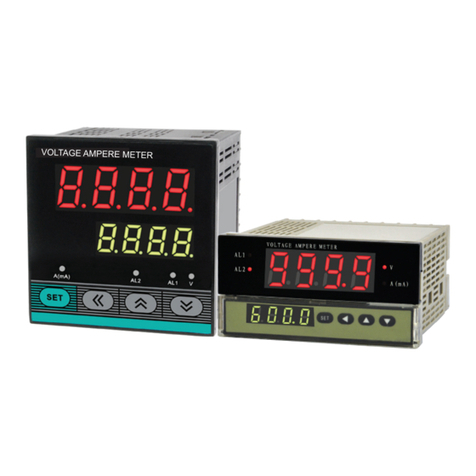
2
Operating description
1. Safety information
1) Watch out for high-voltage electric shock. When
completing the insulating resistance test, remove the test cable
only after making sure high voltage across the tested object is
less than 50V.
2) During measurement, do not touch the object under test
and watch out for high-voltage electric shock.
3) When test the insulating resistance, the object should
not be electrified. Make sure the to-be-tested object is securely
earthed. Before test, it is necessary to short-circuit and
discharge two test terminals of the to-be-tested object.
4) When test the insulating resistance, make sure no
external voltage is applied to the test circuit.
5) Before starting test, make sure position of the range
switch knob is correct and the test cable is securely connected.
6) After press the high voltage key, high voltage from
250V to 1000V will be output between L terminal and E
terminal (depending on different models and positions). Here,
be sure not to touch the meter and exposed part of the object
under test. Otherwise, danger of electric shock would occur.
2. Insulating resistance test
1) Connection of the test terminals
Insert one red the test pen into L terminal socket of the
meter. Insert one end of the test cable with a red test clamp
into E terminal socket of the meter. Insert one end of the test
cable with a black test clamp into G terminal socket of the
meter. Make a good connection respectively.
2) Test connecting cable
Connecting cable of E terminal socket of the meter is
earthing cable;
Connecting cable of L terminal socket of the meter is circuit
cable;
Connecting cable of G terminal socket of the meter is
shielding cable and connected to surface of the to-be-tested
object to prevent surface leakage and affect impedance test.
3) Rated voltage selection
Select a rated voltage you need in the insulating resistance
test. Turn the range switch knob to a corresponding voltage
position.
4) Connect pen of the test bar to another terminal of the
to-be-tested object. Press high voltage switch
(TEST/STOP). Here, the red indicator light turns on,
indicating high voltage output for test is connected. Actual
high voltage value can be displayed in the meter. After
the test is started, numerical value is displayed in the
meter.
Attention: do not short-circuit the two test pens with high
voltage output or take measurement of insulating resistance
after high voltage is output. The improper operation is very
easy to generate spark, cause fire disaster, and damage the
meter.
Special attention in operation:
Before test, make sure the to-be-tested circuit is not
electrified. Do not take measurement of any electrified
equipment or electrified circuit. During test, dangerous
voltage output exists in the meter. Be sure to operate it
carefully. Ensure the to-be-tested object is securely clamped
and keep your hands away from the test clamp before press
TEST key to output high voltage.
Attention in operation:
When use 500V measurement voltage to measure resistance
less than 1.5MΩ, 1000V to measure resistance less than 5MΩ,
measurement time must not exceed 10 seconds.
5) Power off
After the test, the release of high-voltage switch (TEST /
STOP), put out the red indicator light, said high-voltage
output has been disconnected.
Range will switch to the OFF position rotation, LCD
screen shows no. The capacitive load, should be first tested
on the target residual charge-finished,to prevent residual
discharge wounding charge, and then removed the test
line, testing completed
VII.Maintenance of the meter
Warning! It is necessary to turn the power off and
disconnect test pens before open the case of the meter or
battery cover to prevent danger of electric shock.
1. When the sign “
” is displayed in the meter, the battery
needs to be changed. Open the battery cover, and replace
the old battery with a new one of the same type to ensure
the meter works normally.
2. Keep the meter and the test pens clean, dry, and undamaged.
Use a clean cloth or eradicator to clean the case of the meter.
Do not use abrasive or organic solvent.
3. Avoid mechanical damage, shock, and impact; avoid
exposure to high temperature and strong magnetic field.
VIII. Accessories
1. Test cable: one set.
2. Operating instructions: one copy
3. Conformity certificate/Warranty card: one piece




















